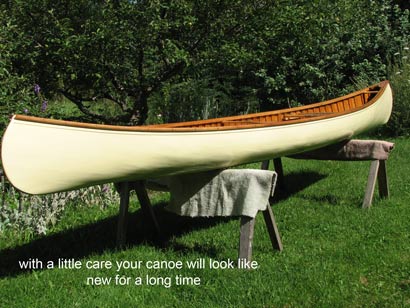Canoe Care
The Care and Maintenance of Your Cedar Canvas Canoe
While nothing can match the beauty and performance of your cedar canvas canoe, it must be remembered that these characteristics are made possible by the use of natural and therefore biodegradable materials. You can be sure that, in the case of a Guild-built canoe, great care has been taken to protect the fine wood and other materials from degradation through the careful use of quality paints and varnishes. However, you as the owner have a crucial role to play as well. With a bit of basic care and maintenance, your cedar canvas canoe will give you, your children and your grandchildren lifetimes of paddling pleasure.
Care
Beside taking reasonable care in the use and transport of your canoe, the single most important factor in retaining its good appearance and condition is the way it is stored when not in use. In this respect, two words are most important: dry and shade. Moisture promotes decay in wood and other natural materials and the ultraviolet rays of the sun eventually degrade most materials, including the protective paint and varnish coatings on your canoe and even the wood itself if it loses the protection of these coatings.
Between uses, your canoe should be removed from the water and turned upside-down on supports which raise it well off the ground. If it must be left on the ground it is preferable to leave the canoe right side up unless, of course, it is raining or may rain, in which case the canoe must be inverted. In either case, it should be in a shaded location if possible. Allowing your canoe to rest inverted on wet grass or soil should be avoided if at all possible. In this position, the parts of the gunwales in contact with the ground are very vulnerable to water damage.
If water accumulates in your canoe as a result of rain or waves, it should be emptied out at the first opportunity. Upon returning to camp or at the end of the day, the canoe should be allowed to dry out in the shade either upside down or right side up. If a shady location isn't available, the canoe should be left right side up to dry.
Keeping excess sand and dirt out of your canoe, especially in the area under the paddlers' feet, will extend the effective life of the varnish protecting the inside. Some experienced paddlers place a piece of tarp or other material in the bottom of their canoe to protect it from feet and equipment and the inevitable mud, sand and water picked up at portages and to prevent this material from finding its way between the canvas and the planks.
For short-term storage, your canoe should be inverted on sawhorses or other such supports in a dry, shaded or covered location with good air circulation. This will allow it to dry slowly but thoroughly. Your canoe should never be kept, even for short periods, upright on saw horses or other such narrow supports as these will cause indentations in the rounded bottom of the canoe.
For extended or between-season storage, your canoe should be inverted on supports which raise it well off the ground or floor under a sheltering roof or, preferably, inside a dry building. Storing your canoe upright on a floor or other flat surface should be avoided since its weight can cause the bottom to be compressed out of shape (especially if it has a keel). For the same reason, your canoe should never be used as a container to store gear between paddling seasons. Keeping your canoe dry and under cover while in storage is very important. Low or changing temperatures are not a problem as long as the above conditions are met.
Maintenance
Your Guild canoe has been carefully varnished and painted to give it an effective protective coating inside and out. Unless damage compromises their effectiveness, these coatings can provide years of service without attention.
The exterior of a canoe is subject to abrasion from scraping over rocks, sand and submerged objects. Should your canoe receive deep scratches that go right through the paint, it should be allowed to dry thoroughly and the damaged areas touched up with paint to restore the waterproof barrier. When the time comes to repaint your canoe, it should be sanded by hand using approximately 180 grit sand paper to remove the gloss, wiped clean and then repainted with two coats of marine enamel.
The varnish coating the inside of your canoe protects the wood from the damaging effects of moisture and the sun. However, the floor of the canoe receives a lot of abrasion from feet, dirt, sand, and equipment. If the varnish barrier is broken, the exposed wood of the cedar ribs and planks will begin to turn grey from the effects of water and the sun. Occasional renewal of the varnish barrier with a new coat of varnish, before it gets into bad shape, will keep the interior of your canoe looking like new.
The gunwales of your canoe are also protected by several coats of varnish. However they also are vulnerable to abrasion damage (in this case from paddles) and may eventually develop bare spots where the varnish has been worn off. If this happens, light sanding and revarnishing will prevent discolouration and keep them looking like new.
you are at the bottom of the 'Canoe Care' page
